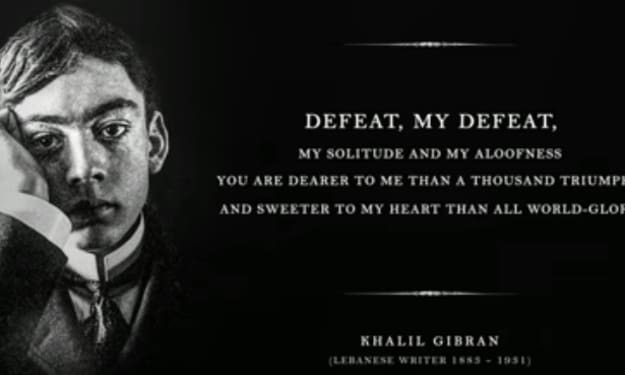
Certainly! Here's an expanded version of the poem:
---
I would not trade the sorrows nestled in my heart
For the fleeting joys of the crowded throng's part.
Let tears of sadness flow from every crevice,
To cleanse my soul and grant profound insights, wise and decisive.
A tear, to purify my innermost being,
Granting me insight, revealing life's unseen meaning.
A smile, to draw me closer to my kin,
The original poem, "A Tear and a Smile" by Khalil Gibran, is a profound exploration of the human experience, encapsulating the duality of emotions and the cyclical nature of life. In this expanded interpretation, we delve deeper into the themes of sorrow and joy, longing and fulfillment, and the eternal journey of the soul.
At its core, the poem speaks to the complexity of human emotions and the interconnectedness of joy and sorrow. Gibran expresses a preference for experiencing the depths of sadness over the superficiality of surface-level happiness. This sentiment challenges the conventional notion that joy is the ultimate goal, suggesting instead that sorrow holds its own value in purifying the soul and revealing life's deeper truths.
The poem opens with a declaration: "I would not exchange the sorrows of my heart for the joys of the multitude." This assertion sets the tone for the exploration of the speaker's inner landscape, where sorrows are embraced as catalysts for growth and understanding. The tears of sadness are not seen as signs of weakness, but rather as symbols of resilience and introspection.
"I would let my life remain a tear and a smile," Gibran writes, invoking the imagery of tear and smile as metaphors for the human experience. The tear symbolizes the pain and suffering that one endures, while the smile represents moments of joy and connection. Together, they form the fabric of existence, weaving a tapestry of emotions that shape the journey of the soul.
The speaker reflects on the transformative power of tears, describing them as a means of purifying the heart and gaining insight into life's mysteries. Through the act of shedding tears, one gains a deeper understanding of oneself and the world around them. This process of emotional catharsis leads to a sense of clarity and enlightenment, enabling the individual to navigate life's challenges with grace and resilience.
In contrast, the smile serves as a bridge between the self and others, drawing the speaker closer to their fellow beings. It is a symbol of empathy and compassion, a gesture of solidarity in the face of adversity. Through the act of smiling, the speaker acknowledges their shared humanity with others, transcending the barriers of individuality and embracing the collective spirit of mankind.
The poem continues with a reflection on the longing for love and beauty, an innate desire that resides deep within the human spirit. The speaker expresses a preference for yearning over complacency, rejecting the notion of contentment as the ultimate goal. Instead, they embrace the hunger for love and beauty as a driving force that propels them forward on their journey of self-discovery and growth.
The imagery of the flower serves as a metaphor for the cyclical nature of life, with its petals opening and closing in rhythm with the rising and setting of the sun. Like the flower, the human experience is characterized by moments of longing and fulfillment, sorrow and joy. Each phase of life brings its own set of challenges and blessings, shaping the individual into who they are meant to be.
The poem draws parallels between the life cycle of a flower and the journey of the soul, both of which are marked by separation and reunion. Just as the flower releases its petals to the wind, the spirit separates from the greater whole to embark on its own path of exploration and growth. Yet, like the cloud that eventually returns to the sea, the spirit ultimately reunites with the divine source from which it originated.
In the final stanza, the poem culminates in a meditation on the transcendent nature of the human spirit. The spirit, like the cloud, traverses the landscape of existence, drifting over mountains of sorrow and plains of joy. Yet, no matter where it roams, it is always guided by the gentle breeze of death, leading it back to the ocean of love and beauty, to God.
In conclusion, "A Tear and a Smile" by Khalil Gibran is a timeless exploration of the human experience, capturing the essence of sorrow and joy, longing and fulfillment. Through its vivid imagery and profound insights, the poem invites readers to embrace the complexity of their emotions and embrace the journey of self-discovery and growth.
A beacon of joy, a symbol of my divine kinship within.
Let my life be a tapestry of tear and smile,
Each emotion weaving a story, mile by mile.
For I'd rather die yearning for love's embrace,
Than live in weariness, in a desolate place.
May the hunger for love and beauty dwell deep within,
For those who are content are often marred by sin.
I've heard the sweet sighs of yearning hearts,
Sweeter than the sweetest melodies, a symphony that imparts.
As evening falls, the flower gently closes its petals,
Embracing its longing, as day settles.
But with the dawn, it eagerly unfurls,
To bask in the sun's warmth, as the new day swirls.
The life of a flower, a dance of longing and fulfillment,
A symphony of emotions, tranquil and resplendent.
Like the waters of the sea, rising to the skies,
Forming clouds that float, a transient guise.
The clouds, a symbol of parting and reunion,
Drifting over hills and valleys, in endless communion.
Just as the spirit separates from the greater whole,
To wander in the realm of matter, with a celestial goal.
Drifting like a cloud, over mountains of sorrow,
Through plains of joy, seeking tomorrow.
Until it meets the gentle breeze of death,
Returning to its source, with each fleeting breath.
And so, the spirit reunites with the infinite,
A tear and a smile, in the grand cosmic exhibit.
Back to the ocean of love and beauty, it flows,
To merge with the divine, where eternity glows.
---
This expanded version elaborates on the themes and imagery present in the original poem, offering a more detailed exploration of its essence.
About the Creator
Enjoyed the story? Support the Creator.
Subscribe for free to receive all their stories in your feed. You could also pledge your support or give them a one-off tip, letting them know you appreciate their work.





Comments
There are no comments for this story
Be the first to respond and start the conversation.